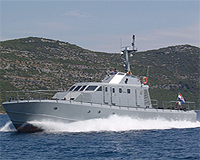| . |  |
. |
Cambridge MD (SPX) May 24, 2010 A new study to be published in the academic journal Reviews in Fisheries Science recommends that efforts to restore the endangered California delta smelt and other declining pelagic fish should more sharply focus on reducing nutrient pollution to the species' native waters. The research indicates these fish populations would greatly benefit from reductions in the amount of nitrogen flowing into the Sacramento-San Joaquin Bay-Delta from wastewater treatment plants and balancing the ratio of nitrogen and phosphorus contained in the discharged water. "While a great deal of emphasis has been placed on ensuring there is enough water for delta smelt, we also need to recognize that the water also has to have the right chemical balance," said Dr. Patricia Glibert of the University of Maryland Center for Environmental Science. "The research shows us that reducing the amount of nitrogen from Bay-Delta wastewater treatment plants should aid the recovery of the delta smelt population. The high nutrient loads are affecting the algae at the base of the food web, which in turn, affect the food supply for the fish. This has altered the ecology of the system over many years." For her research, Dr. Glibert analyzed 30 years of water chemistry, river flow, plankton, fish population and effluent discharge data to determine possible linkages to the population of the delta smelt and other pelagic fish in the Bay-Delta system. The analysis reveals that declines in delta smelt population most closely coincide with effluent changes from the region's major wastewater treatment plant. "The effect of nutrient loading on fish populations has been in debate for some time," said Dr. Glibert. "While the current rate of wastewater discharge is within established permit and nutrient criteria guidelines, the ecology appears to require environmental conditions more favorable than these guidelines. In this study, a broad-scale, long-term approach was taken to understand how nutrients are related to the food web." "Reviews in Fisheries Science is pleased to publicly release this research prior to being published in our print edition," said journal editor Dr. Sandra E. Shumway of the University of Connecticut. "We believe this research will contribute to the regional public discussions about this issue and will have significance for other nutrient impacted coastal systems elsewhere as well." A professor of ecology and oceanography at the University of Maryland Center for Environmental Science Horn Point Laboratory and member of the National Academy of Sciences committee examining sustainable water and environmental management in the California Bay-Delta, Dr. Glibert's research focuses on nitrogen cycling, harmful algal blooms and their relationships with the food web. In addition to this research, Glibert is conducting, or has recently completed, research projects in Chesapeake Bay, Florida Bay, the Arabian Sea, East China Sea, and Australia and she currently serves as co-Chair of the international working group on land based nutrient pollution and harmful algal blooms. The San Francisco Estuary, which encompasses the Sacramento-San Joaquin Bay Delta, is one of the largest estuarine systems on the Pacific Coast as well as one of the largest managed and engineered water systems in the United States. It is the largest source of municipal and agricultural fresh water in California and is home to several economically important fisheries. The Bay-Delta is the subject of considerable national public awareness due to the sociopolitical and socioeconomic tension surrounding the plight of the endangered delta smelt (Hypomesus transpacificus) and the court-ordered modifications of water diversion projects to protect the species.
Share This Article With Planet Earth
Related Links University of Maryland Center for Environmental Science Water News - Science, Technology and Politics
 Canada cuts navy's coast patrols
Canada cuts navy's coast patrolsOttawa (AFP) May 13, 2010 Canada's navy will mothball half of its fleet of 12 Atlantic, Pacific and Arctic coastal patrol vessels due to a lack of funding, a navy spokesman said Thursday. The navy's fiscal 2010-2011 budget is "sufficient to support six Kingston class vessels at standard readiness," Lieutenant Gabriel Rousseau told AFP. The rest of the fleet will remain moored at the ports of Halifax, Nova Scotia ... read more |
|
| The content herein, unless otherwise known to be public domain, are Copyright 1995-2010 - SpaceDaily. AFP and UPI Wire Stories are copyright Agence France-Presse and United Press International. ESA Portal Reports are copyright European Space Agency. All NASA sourced material is public domain. Additional copyrights may apply in whole or part to other bona fide parties. Advertising does not imply endorsement,agreement or approval of any opinions, statements or information provided by SpaceDaily on any Web page published or hosted by SpaceDaily. Privacy Statement |